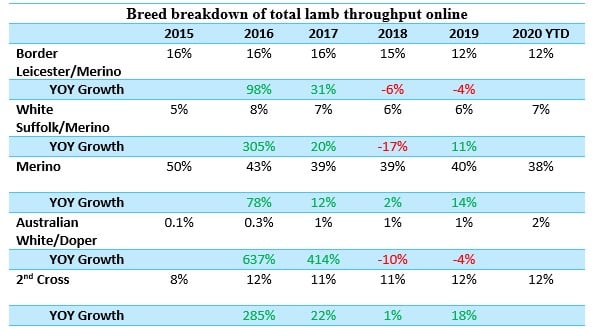With spring already knocking on our doorstep, widespread above average seasonal conditions have pre-empted a bumper lamb crop for 2020. This is an exciting step in addressing the critical herd rebuilding stage currently faced across the nation.

Table 1: Throughput percentage of lamb breeds listed on AuctionsPlus compared against total annual lamb throughput between 2015-2020. YOY Growth percentage based off total annual number of head listed for each respective breed category.
As depicted in Table 1, Merino lambs are clear ringleaders of AuctionsPlus lamb listings between 2015-2020. However, it is evident that their dominance is being diffused through the increasing popularity of first and second cross breeds which have continued to gain traction with producers over recent years.
The traditional first cross ewe breeding and paternal dominance of the Border Leister and Merino is being challenged, with Border Leicester/Merino lambs seeing a 4% decrease in total throughput listings since 2015 and Merino lambs seeing a 12% decrease in overall throughput figures. When this is compared with YOY growth however, First Cross Border Leicester lambs see a large increase in 2016 and 2017 with slight growth reductions in 2018 and 2019, whereas Merino lambs have seen ongoing YOY growth since 2015 despite their reduced total throughput percentage.
The changing composition of the Australian lamb flock as a result of ewes joined with meat breeds depicts how producers, many of which are emerging from previous seasons of relentless drought, are focusing on breeding lambs for meat production to yield a higher turnover. This is a fundamental and potentially short-term shift from the traditional focus of replacing breeding stock and lambs for wool production to focusing on increased cash flow with the goal of cashing-in on strong prime and store lamb prices due to limited supply.
Whilst there will always be a market for Merino and first cross ewes, it is evident that many producers are looking to other breeds as there is strong potential for prime lambs in the store market. Table 1 highlights the growing momentum of the emerging Australian White and White Suffolk sired breeds as inroads to the prime lamb breeding industry, particularly seen in Australian White/Dorper listings which have increased from just shy of 500 head in 2015 to over 11,000 in 2019. Additionally, notable exponential YOY growth in both Australian White and White Suffolk sired lambs is evident, particularly between 2016 and 2017 where strong seasonal conditions amplified the amount of these lambs seen online. With a 180o flip in seasons from 2019, it will be interesting to see what 2020 will bring for first and second cross lamb listings.
White Suffolk sired lambs are seeing continual overall growth since 2015, with total lamb throughput increasing 2-3% and large YOY growth seen in 2016 and 2017 with listings slightly back in 18/19 due to tough seasonal conditions. For the 2020 year to date (YTD), the top purchasing regions for White Suffolk’s are spread across two states which include the NSW Central West which purchased 14,789 head, followed by South Western Victoria, NSW Riverina, SW Slopes and Planes and Northern Victoria, respectively.

Merino lamb purchasing regions have remained relatively consistent between 2015-2020 however challenging seasonal conditions across most of the country and particularly in areas such as the NSW Central west in previous years are clearly represented in Figure 2.
The graph highlights where purchasing numbers significantly decline as producers enact drought management procedures such as destocking and holding onto key breeding stock. The 2020 YTD shows exciting signs of stock returning to these key purchasing regions (as mentioned in a previous AMI article- https://bit.ly/CWsheepmovements ) and will be interesting to observe how the store lamb season evolves over coming months.
Lorem Ipsum is simply dummy text of the printing and typesetting industry. Lorem Ipsum has been the industry's standard dummy text ever since the 1500s
Subscribe to our weekly newsletter and monthly cattle, sheep, and machinery round-ups.